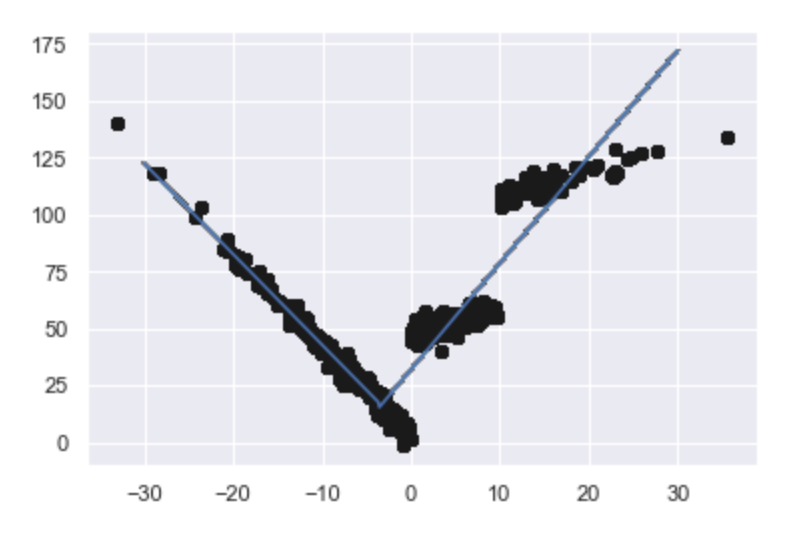I am trying to create a piecewise linear regression to minimize the MSE(minimum square errors) then using linear regression directly. The method should be using dynamic programming to calculate the different piecewise sizes and combinations of groups to achieve the overall MSE. I think the algorithm runtime is O(n²) and I wonder if there are ways to optimize it to O(nLogN)?
import numpy as np
from sklearn.metrics import mean_squared_error
from sklearn import linear_model
import pandas as pd
import matplotlib.pyplot as plt
x = [3.4, 1.8, 4.6, 2.3, 3.1, 5.5, 0.7, 3.0, 2.6, 4.3, 2.1, 1.1, 6.1, 4.8,3.8]
y = [26.2, 17.8, 31.3, 23.1, 27.5, 36.5, 14.1, 22.3, 19.6, 31.3, 24.0, 17.3, 43.2, 36.4, 26.1]
dataset = np.dstack((x,y))
dataset = dataset[0]
d_arg = np.argsort(dataset[:,0])
dataset = dataset[d_arg]
def calc_error(dataset):
lr_model = linear_model.LinearRegression()
x = pd.DataFrame(dataset[:,0])
y = pd.DataFrame(dataset[:,1])
lr_model.fit(x,y)
predictions = lr_model.predict(x)
mse = mean_squared_error(y, predictions)
return mse
#n is the number of points , m is the number of groups, k is the minimum number of points in a group
#(15,5,3)returns 【【3,3,3,3,3】】
#(15,5,2) returns [[2,4,3,3,3],[3,2,4,2,4],[4,2,3,3,3]....]
def all_combination(n,m,k):
result = []
if n < k*m:
print('There are not enough elements to split.')
return
combination_bottom = [k for q in range(m)]
#add greedy algorithm here?
if n == k*m:
result.append(combination_bottom.copy())
else:
combination_now = [combination_bottom.copy()]
j = k*m+1
while j < n+1:
combination_last = combination_now.copy()
combination_now = []
for x in combination_last:
for i in range (0, m):
combination_new = x.copy()
combination_new[i] = combination_new[i]+1
combination_now.append(combination_new.copy())
j += 1
else:
for x in combination_last:
for i in range (0, m):
combination_new = x.copy()
combination_new[i] = combination_new[i]+1
if combination_new not in result:
result.append(combination_new.copy())
return result #2-d list
def calc_sum_error(dataset,cb):#cb = combination
mse_sum = 0
for n in range(0,len(cb)):
if n == 0:
low = 0
high = cb[0]
else:
low = 0
for i in range(0,n):
low += cb[i]
high = low + cb[n]
mse_sum += calc_error(dataset[low:high])
return mse_sum
#k is the number of points as a group
def best_piecewise(dataset,k):
lenth = len(dataset)
max_split = lenth // k
min_mse = calc_error(dataset)
split_cb = []
all_cb = []
for i in range(2, max_split+1):
split_result = all_combination(lenth, i, k)
all_cb += split_result
for cb in split_result:
tmp_mse = calc_sum_error(dataset,cb)
if tmp_mse < min_mse:
min_mse = tmp_mse
split_cb = cb
return min_mse, split_cb, all_cb
min_mse, split_cb, all_cb = best_piecewise(dataset, 2)
print('The best split of the data is '+str(split_cb))
print('The minimum MSE value is '+str(min_mse))
x = np.array(dataset[:,0])
y = np.array(dataset[:,1])
plt.plot(x,y,"o")
for n in range(0,len(split_cb)):
if n == 0:
low = 0
high = split_cb[n]
else:
low = 0
for i in range(0,n):
low += split_cb[i]
high = low + split_cb[n]
x_tmp = pd.DataFrame(dataset[low:high,0])
y_tmp = pd.DataFrame(dataset[low:high,1])
lr_model = linear_model.LinearRegression()
lr_model.fit(x_tmp,y_tmp)
y_predict = lr_model.predict(x_tmp)
plt.plot(x_tmp, y_predict, 'g-')
plt.show()
Please let me know if I didn't make it clear in any part.





